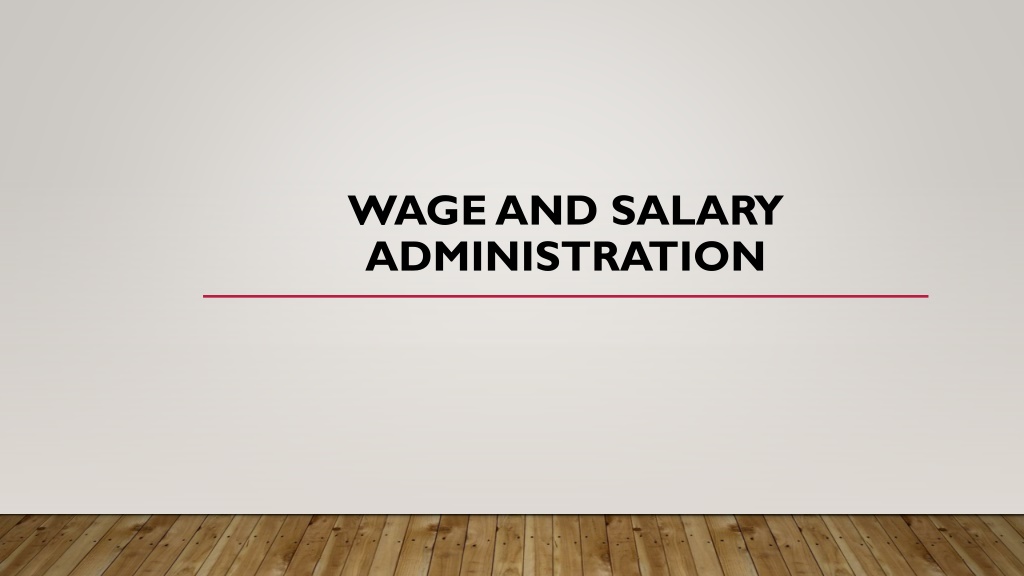Understanding Wage and Salary Administration in Organizations
Explore the concept of wage and salary administration in organizations, encompassing definitions of wages, salaries, compensation, and the nature and characteristics of wage administration. Learn about the importance of establishing equitable pay structures, balancing personnel interests, and motivating employees through fair compensation practices.
Download Presentation

Please find below an Image/Link to download the presentation.
The content on the website is provided AS IS for your information and personal use only. It may not be sold, licensed, or shared on other websites without obtaining consent from the author. Download presentation by click this link. If you encounter any issues during the download, it is possible that the publisher has removed the file from their server.
E N D
Presentation Transcript
WAGE AND SALARY ADMINISTRATION
COMPENSATION Compensation may be defined as money received in the performance of work, plus the many kinds of benefits and services that organizations provide to their employees. Money is included under direct compensation (popularly known as wages, i.e., gross pay); while benefits come under indirect compensation, and may consist of accident and health insurance, the employer s contribution to retirement, pay for vacation or illness, and employer s required payments for employee welfare as social security.A wage (or pay) is the remuneration paid,for the service of labour in production, periodically to an employee/worker. Wages usually refer to the hourly rate or daily rate paid to such groups as production and maintenance employees ( blue-collar workers ). Indian Labour Organisation (ILO) defined the term wage as the remuneration paid by the employer for the service of hourly,daily,weekly and fortnightly employees .
Salary normally refers to the weekly or monthly rates paid to clerical, administrative and professional employees ( white-collar workers ).Earnings are the total amount of remuneration received by an employee during a given period. This includes salary, dearness allowance, house rent allowance, city compensation allowance, other allowance, overtime payments,etc.
WAGE AND SALARY ADMINISTRATION Wage and salary administration is defined as the process by which wage and salary levels and structures are determined in organisational settings. Wages are payments for labour services rendered frequency, expressed in hourly rates, while a salary is a similar payment, expressed in weekly,monthly or annual rates. Thus the term wage frequently connote payments in terms of the number of hours worked and may fluctuate depending upon hours actually worked. The determination of wage rates, administration of wage policies and satisfying the employees as regards to wages and rates of wages is an important aspect of wage administration.As a matter of fact wage and salary administration is one of the major responsibilities of modern manpower management.
NATURE: 1. The basic purpose of wage and salary administration is to establish and maintain an equitable wage and salary structure. 2. It is concerned with the establishment and maintenance of equitable labour cost structure i.e. an optimal balancing of conflicting personnel interest so that the satisfaction of the employees and employers is maximised and conflicts are minimised. 3. The wage and salary administration is concerned with the financial aspects of needs,motivation and rewards. 4. Employees should be paid according to the requirements of their jobs i.e. highly skilled jobs are paid more compensation than low skilled jobs. 5. To minimise the chances of favouritism. 6. To establish the job sequences and lines of production wherever they are applicable. 7. To increase the employees morale and motivation because a wage programme can be explained and is based upon facts.
CHARACTERISTICS: 1. Payment of wages is in accordance with the terms of contract between the employer and the worker. 2. The wages are determined on the basis of time-rate system or piece-rate system. 3. Wages change with the change in the time spent by the labourer. 4. Wages create utility. 5. Wages may be paid weekly,fortnightly,hourly,or on monthly basis. 6. Wage is the reward paid to the workers for the services rendered by them. 7. Wages can be paid in cash or in kind.8.All kinds of allowances are included in wages.
OBJECTIVES: i. To compare or draft company HR policy ii. Find out the income level and return ratio of similar industries iii. To understand wage differentiations iv. To examine the competitiveness of entry level employees v. To establish hiring rates favorable to the community vi. To keep abreast wage and salary rates with production cost vii. To minimize labour turnover due to pay disparity viii. To increase employee s satisfaction and morale ix. To learn about the trend of perks and benefits in the market x. To resolve existing labour problems concerning compensation.























